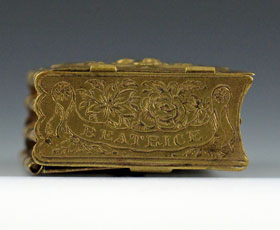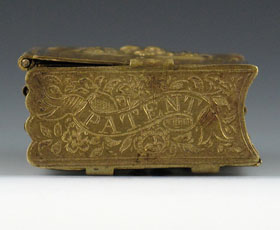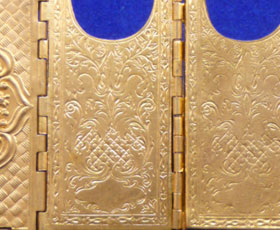Beatrice - 6 Sections

Needle Case

Patent
Design Details
Needle Case Type: |
Accordion |
Patent/Registered to: |
James William Lewis, Die-sinker from Birmingham and George Archbold, Rouge Manufacturer from Handsworth |
Patent/Design Representation #: |
Mechanical Patent: #603 |
Patent/Design Registration Date: |
March 4, 1867 |
Location of Patent/Design Registration: |
British Library - Business and Intellectual Property Centre – London |
Reference #: |
1867-603 |
Dimensions: |
2.6 x 4.6 |
Material: |
Brass |
Name Variations: |
a) H. Milward & Sons - Redditch (the sole source of this information is Horowitz and Mann as no example of this needle case
with this company name has been seen by the authors of this website)
b) Perry & Co - London (the sole source of this information is Horowitz and Mann as no example of this needle case
with this company name has been seen by the authors of this website)
c) Unmarked |
Interior Variations |
a) Internal panels with acorn/pineapple pattern on both sides
b) Interior panels with long stem bouquets on both sides
|
Other Variations: |
Beatrice - 4 Sections
Beatrice - Sharpe version
Gem - 4 Sections
Gem - 6 Sections |
Additional Photographs


Name and patent detail


Interior panel with long stemmed bouquets and another interior panel with acorn/pineapple pattern (photo courtesty of Lynda Herrod)
Facts
Beatrice was the youngest child of Queen Victoria and Prince Albert. She was born in 1857 and never really knew her father who died
when she was only four years old. Since her four sisters were much older, she became very close to her mother. Beatrice lived
for 87 years and experienced the Victorian and Edwardian periods as well as the Great War (WWI) and World War II. Below: 1862 drawing of
Queen Victoria holding Beatrice.

Early History
Beatrice was born in Buckingham Palace and her birth caused a bit of controversy as it was the first birth in which the Queen used chloroform
to relieve delivery pain. At the time it was considered quite dangerous. Although the Queen was known to dislike babies in
general, she developed a special fondness for Beatrice as did her father Prince Albert. When Albert and the Queen’s mother both died in
1861, Beatrice and the Queen became even closer. By 1871 all of Beatrice's sisters were married so she became Queen Victoria’s
devoted companion for the remainder of the Queen’s life.

Later Life
Beatrice fell in love with Prince Henry of Battenberg, Germany. The Queen only consented to their marriage if Henry agreed to give up his
German obligations and live in England with Beatrice and the Queen. They were married in 1885 and had four children. Unfortunately
Beatrice’s’ life mirrored her mother’s in several ways as Henry died in 1896 and then the Queen died five years later in 1901. Although
Beatrice was devastated, her appearance at court diminished since she was not close to her brother, who became King Edward VII. Beatrice
focused most of her attention on her children and in transcribing and editing Queen Victoria’s journals. As she aged she retired from
public life. During the Great War her surname was anglicized and her sons gave up their “Prince of Battenberg” titles and became Sir and
Lord Mountbatten. Beatrice died peacefully in 1944.














